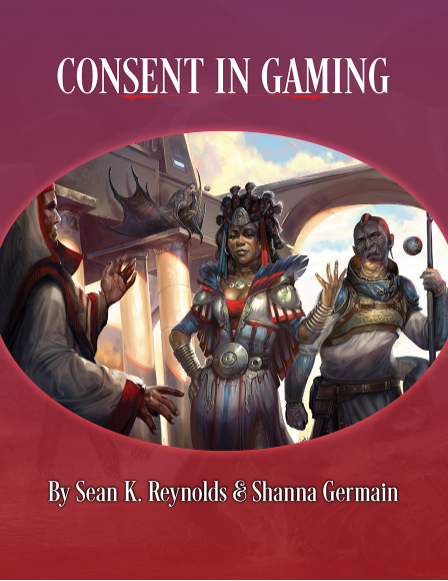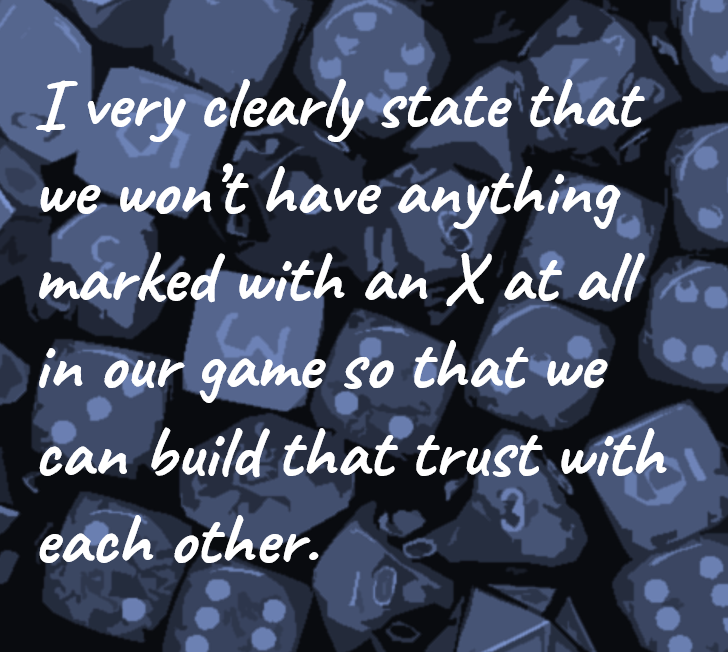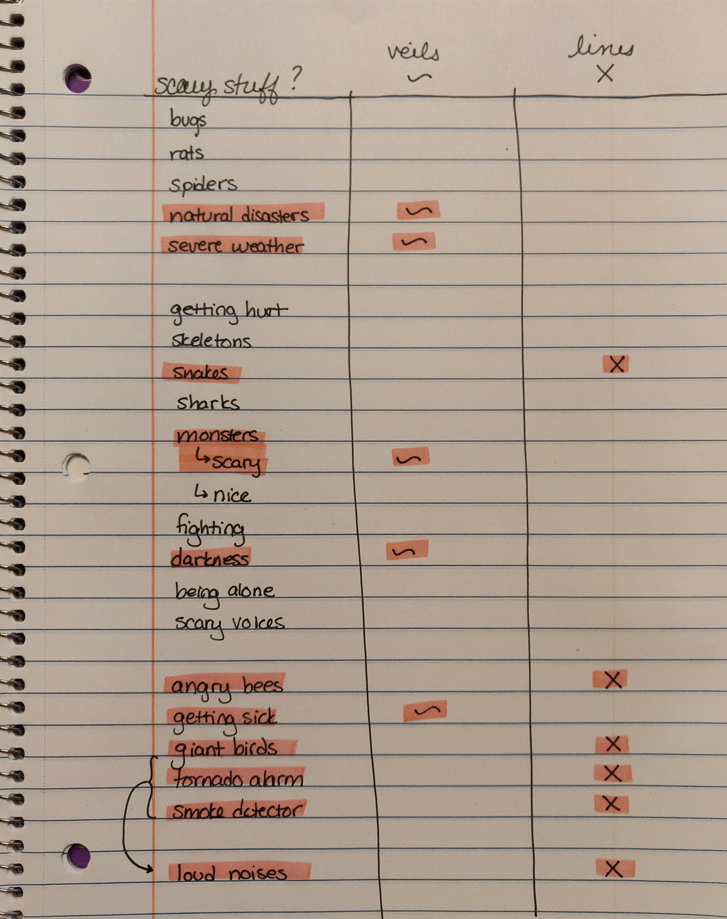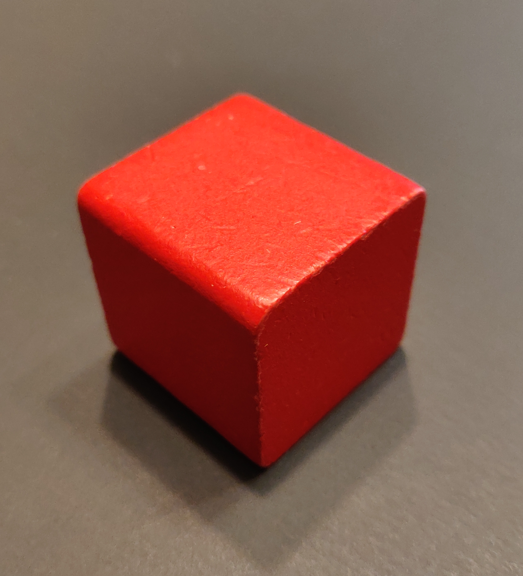Tabletop RPG safety tools for kids: 4 quick steps to learn and respect boundaries
This article is sponsored by Almost Bedtime Theater, an actual play podcast about playing TTRPGs for and with kids! Thank you ABT for supporting this post!
To start, my process usually looks like this (links go to sections in the article):
- Narrow down a list of triggers
- Establish lines and veils
- Ask your kid for triggers
- Use an in-game safety tool
There are a lot of different methods to use instead of or in addition to these, so this is by no means a limit. I am sharing what I have developed over time with my kid, I hope it helps provide you with a quick process that you can adjust to your particular kid as well.
Narrow down a list of common tabletop RPG triggers
When I am starting out my tabletop RPG safety tools process with my kid, I like to use a trigger list that I’ve narrowed down to establish a base for us to review and add to.
Trigger lists can be used to ask players very clearly what they are and aren’t comfortable with in the game, and Monte Cook Games has a great list of common tabletop RPG triggers at the end of their free resource, Consent in Gaming.

Consent in Gaming is a great explanation from front back that I very much recommend to read in full. For the list at the end though, because it is doing such a good job covering everything, the full consent form can be a bit heavy to give to kids as is (it covers topics from horror to intimacy that your child might not be ready to talk about yet).
To build a base for your safety tool, I would recommend that you narrow down the trigger list to anything that YOU approve of for a tabletop RPGs with your particular kid(s) and then add anything extra that you think they might be afraid of (and don’t worry, we will get their feedback and additions, it is just a bit later, and I’ll explain why).
For tabletop RPG’s with my particular kid, I narrowed down the original Monte Cook Games list to:
- Bugs
- Rats
- Spiders
- Natural disasters
- Severe weather
And then I added some things I know my kid has been afraid of in the past:
- Injuries
- Skeletons
- Snakes
- Sharks
- Scary monsters
- Friendly monsters
- Fighting
- Darkness
- Being alone
- Scary voices
Establish lines and veils in your tabletop RPG with your kid’s help
With our narrowed down list, I now review our tabletop RPG safety tool base list with my kid to establish what’s called commonly called lines and veils for our game.
Because my kid can’t read yet, I do need to review the trigger list with him verbally, but for kids who can read, it may help to let them fill out the sheet on their own so they can think about it and not feel pressured to answer one way or another. Especially in tabletop RPG’s with multiple kids, it may help to keep responses separate to respect each kid’s privacy.
Lines are like hard stops – things that you do not want at all in the game. An example of a line for my kid is: if my kid is afraid of spiders and says they’re way too scary, that’s a line, and I don’t even mention spiders in the game. If we want to address that fear, we can deal with it another time when my kid is actually ready.

When describing lines to my kid, I explain it as something that we won’t talk about in the game, and I’ll mark it with a big X.
Veils are things that you are OK to talk about but you don’t want to actually have them happen to your tabletop RPG character or maybe directly in the game’s story. An example of a veil with my kid is: if my kid doesn’t want his character to be in a lighting storm in the game but is OK about hearing that a big tree in the middle of town was hit by lighting during a storm, that’s a veil.
When describing veils to kiddo, I explain it as something that happened far away or maybe a long time ago, and I’ll mark it with a squiggle.
We go through the list to talk about and mark each item so we know we’re on the same page when it comes to our tabletop RPG’s content. I very clearly state that we won’t have anything marked with an X at all in our game so that we can build that trust with each other.
Ask your kid what else might be a concern during a tabletop RPG
I intentionally put this section of our tabletop RPG safety tools journey after the lines and veils portion because I feel that it’s important to establish some examples, show your kids that they will be heard, and demonstrate what we’ll do with their information first in order to build understanding and trust. For kids who are maybe a bit older or can make the connections more easily, you can definitely combine this section with the first one.
So, now that your kid has some examples of what triggers are and also knows you are listening, ask what other things they have concerns with seeing in the game to see if there’s anything you missed.
For my kid, I frame simply it as, “is there anything else that is too scary for our game?” or “is there anything else you don’t want in the game?”
My kid has come up with a few extras to add over time including:
- Angry bees (he was OK with other bugs)
- Getting sick
- Giant birds
- The tornado alarm
- The smoke detector
So, we added them to our safety tool list, and we go through the lines and veils process with these as well. Here is an example of our current safety tool list – this took maybe 10 minutes to actually write down and review:

Not all of these (like the tornado alarm or smoke detector) are going to be relevant to our tabletop RPG, but I made sure to still show that I was putting them on the list so kiddo knew I was taking this seriously. It also clued me in that he’s way more sensitive to loud noises than I though, so I factor that into our games as well now.
I was really proud of my kid for identifying some fears and then trusting me enough to tell me what they were. In addition to making our tabletop RPG space feel safe, it also helped me to understand kiddo better and clued me on a few things that I needed to pay more attention to.
Pick an in-game tabletop RPG safety tool that your kid understands
The last safety tool that I use in our TTRPG’s with kiddo is an emergency stop that lets my kid halt the game if anything ever gets to be too much.
This could result from hitting a topic that we missed in our list, from getting frustrated with poor rolls, or just not wanting to play anymore. All of those are part of a kid’s limits and boundaries, even if they aren’t a specific topic on a list, and they need to be respected.
There’s a few methods out there for tabletop RPG’s in general, like giving the table permission to pause the game at any time or texting the DM privately to pause the game in a discreet way. There’s also the X-card by John Stavropoulos or Traffic Lights by Bläckfisk Publishing that are good references and options that I’ve used in tabletop RPGs with my regular groups while trying to figure out what works best for my group and me.
For tabletop RPGs with my kid, I went for something as simple as I could think of, which was using a building block (or other toy) as a signal. At the start of the game, I give my kid a wooden building block and say “if you want to stop the game because it is scary or you’re done playing or for any other reason, hold up the block, and we will stop.”

And it works so well! Especially when my kid was younger and not as talkative as now, it was a lot easier for him to hold up a block than it was to try to explain feelings in the middle of getting overwhelmed. It serves the same purpose as other tabletop RPG safety tools listed above, but my kid easily understands and can use this without needing to read or understand symbols or codes.
Of course… there are moments when my kid thinks it is hilarious to hold the block up over and over again to see if I’ll still stop the game. When that happens, we stop, we check in, we maybe laugh a bit if my kid really is just being goofy, and then ne settles down. What it shows though is that we’re going to respect boundaries even if my kid is testing them, and building that trust is important both for a smooth tabletop RPG and for having a healthy parent-child relationship.
Thank you for reading, and I hope these tools help you find some options that work for your particular kid! Please let me know in the comments your thoughts and ideas – I would love to hear them, especially for growing my own process here.
If you liked this post, make sure to subscribe to the TTRPGkids monthly newsletter to stay up to date on the latest reviews, tips and tricks, game and podcast list updates, and more! Thank you for playing tabletop RPGs with your kids and sharing this awesome hobby with the next generation!



Why would anyone want to play one of these games if you need a list of triggers to avoid. What goes on in these games? Seems like kids should stay away.
Hello, I appreciate your question! In tabletop RPGs, you or a facilitator make the story up with your players (you collectively feedback between each other about what happens in the environment and what their character is doing). Some of the triggers that we talk about are things that can generally show up in games as a plot element or something a character might do that aren’t going to trigger all kids but may trigger some, so this helps to parse that out for your particular kid(s) so you make a game that is specifically “rated” for them since you have control over the story. In the sample I gave in the article, one of the possible triggers was spiders (either being used in a description of an old house or as a scary creature) and another one was extreme weather (like having to find shelter from a really bad thunderstorm). These are definitely things that show up in G-rated kid’s shows and movies and could also definitely show up in a kid’s game as you introduce plot elements to them without it being considered inappropriate. However, those examples might also make some kids uncomfortable (and not willing to play anymore), so it is always good to check and see where they are and what they want before making a story that includes those – this provides a clear method for that process. I would also say that, as a parent or facilitator, if you use a premade story for your games (so not 100% improving your own) and feel that it is inappropriate for your kid(s), like you said, stay away from that one (or adjust it to take out the triggering items). Using safety tools helps us to understand where our kids are and what they are comfortable with though so we don’t have to stay away from all tabletop RPGs and so we can make a game space that our kids enjoy.